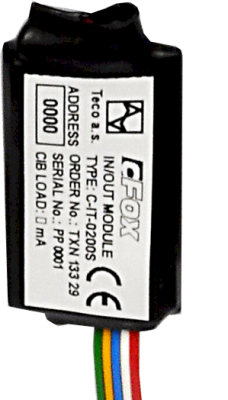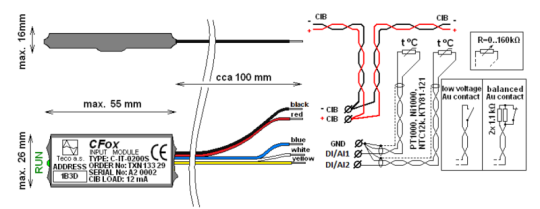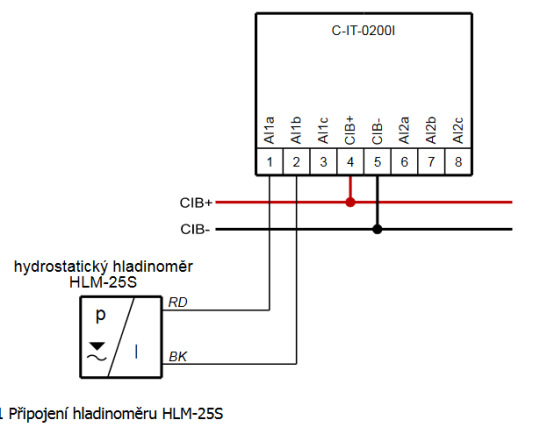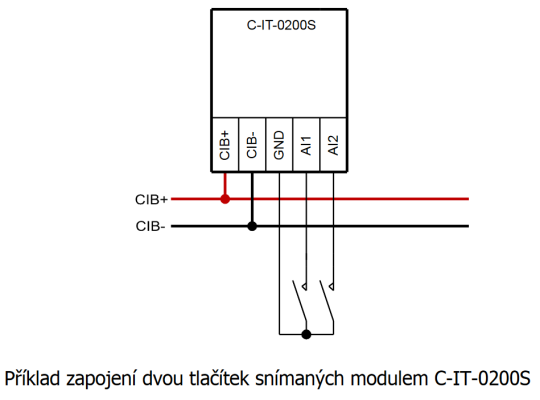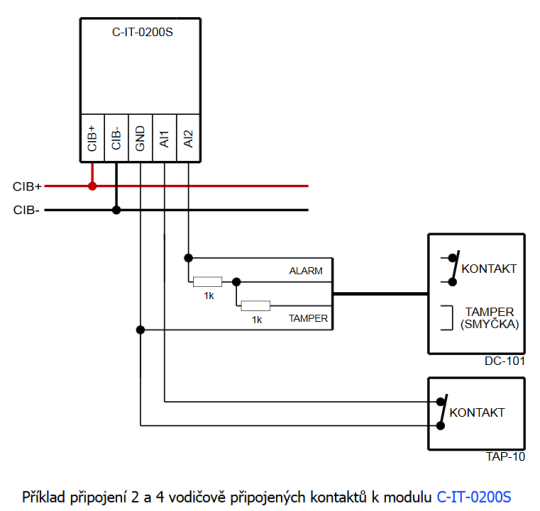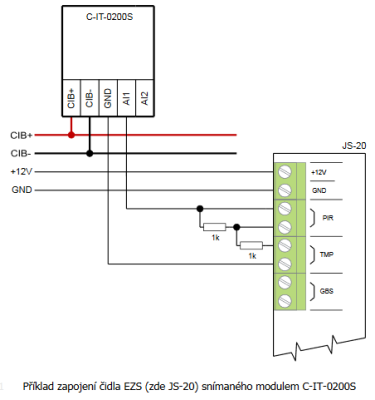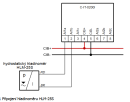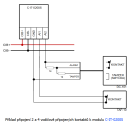C-IT-0200STXN 133 29
C-IT-0200S, CIB, 2x AI/DI RTD or contact
| DI | |
|---|---|
| DI/AI | 2x DI/AI |
| DO | |
| AI | |
| AO | |
| COM | 1x CIB slave |
| SENSOR |
| Picture | Variant | Variant description |
|---|---|---|

|
C-IT-0200S |
The C-IT-0200S module is intended for connection of two passive temperature sensors or binary signals from contacts and their conversion to the CIB wiring bus.
The resistance from the optional Pt1000, Ni1000, NTC 12k, KTY81-121 sensors against the common GND conductor is linearized in the module and converted directly to a numerical temperature value and then transferred to the basic module via the CIB bus. It is possible to choose the measurement of other resistances in the range of 0 to 160 kΩ, but the conversion to temperature and linearization must be performed in the control panel at the level of the application program.
The resistance from the optional Pt1000, Ni1000, NTC 12k, KTY81-121 sensors against the common GND conductor is linearized in the module and converted directly to a numerical temperature value and then transferred to the basic module via the CIB bus. It is possible to choose the measurement of other resistances in the range of 0 to 160 kΩ, but the conversion to temperature and linearization must be performed in the control panel at the level of the application program.
| Order num. | TXN 133 29 |
|---|---|
| Teco code | TXN 133 29 |
| Categories | CFox - Built-in modules |
| Tags | Sales and production discontinued |
| COM - System buses | |
|---|---|
| CIB - Common Installation Bus (R): Installation I/O bus | 1x CIB slave |
| DI - Organization of binary inputs | |
| Total number of binary inputs | 2 |
| Number of groups of binary inputs | 1 |
| Organization of binary inputs into groups | 2x DI (DI/AI1, DI/AI2) |
| DI - Parameters of binary inputs DC (group A) | |
| Parameters valid for inputs on the terminals | DI/AI1, DI/AI2 |
| Number of inputs in group | 2 |
| Common wire | GND - module ground |
| Combined input type | DI/AI Active, for sensing potential-free contacts and measuring resistance sensors |
| Galvanic isolation of inputs from internal/peripheral circuits | No |
| Max. measuring voltage on the connected contact | 3,3 V DC |
| Internal input resistance | 2 kΩ |
| Max. resistance for closed contact, log. 1 | < 0,5 kΩ |
| Min. resistance for open contact, log. 0 | > 1,5 kΩ |
| AI - Organization of analog inputs | |
| Total number of analog inputs | 2 |
| Number of inputs per group | 2 |
| Number of analog input groups | 1 |
| Organization of analog inputs into groups | 2x AI (DI/AI1, DI/AI2) |
| Input type | With common clamp |
| Common wire | GND terminal |
| Galvanic separation from internal circuits | No |
| AI - Analog Input Ranges (Group A) | |
| Parameters valid for inputs on the terminals | DI/AI1, DI/AI2 |
| Passive sensor | Pt1000, W100 = 1,385 (-90 to +320 °C) |
| Passive sensor | Pt1000, W100 = 1,391 (-90 to +320 °C) |
| Passive sensor | Ni1000, W100 = 1,500 (–60 to +200 ° C) |
| Passive sensor | Ni1000, W100 = 1.617 (-60 to +200 ° C) |
| Passive sensor | Resistance transmitter 0-160 kOhm |
| Passive sensor | KTY81-121; PTC thermistor (-55 to + 125 °C) |
| Passive sensor | NTC Thermistor 12k / 25 °C (-40 to + 125 °C) |
| DI: Voltage-free contact | 0 when> 1.5 kOhm, 1 when <0.5 kOhm |
| DI: Balanced resistance input | 2x 1k1 (tamper/0/1/tamper) |
| Resistance measurement error - maximum error at 25 ° C | ± 0.5% of full scale |
| Power supply | |
| Supply voltage, tolerances | 24/27 V DC from CIB bus |
| Power supply from CIB - typical current consumption (mA) | 10 mA |
| Power supply from CIB - maximum current consumption (mA) | 12 mA |
| Power supply from CIB - Galvanic separation of power supply from internal circuits | No |
| Power supply from CIB - internal protection | Yes, returnable fuse |
| Size and weight | |
| Weight approx. | 7 g |
| Product dimensions (width x height x depth) | 55 x 26 x 16 mm |
| Operating conditions, product standards | |
| Product standard | ČSN EN 60730-1 ed. 2:2001 (mod IEC 60730-1:1999) |
| Protection class of electrical object | I, according to ČSN EN 61140 ed.3: 2016 (idt IEC 61140:2016) |
| IP rating (Ingress Protection) according to ČSN EN 60529: 1993 (idt IEC 529: 1989) | IP10B |
| Operating areas | Normal according to ČSN 33 2000-1: 2003 (IEC 364-1: 1992 mod) |
| Degree of pollution | 1, according to ČSN EN 60664-1 ed.2:2008 ( idt IEC 60664-1:2007) |
| Overvoltage category installation | II, according to EN 60664-1 ed_2: 2008 (idt IEC 60641-1: 2007) |
| Type of device | In the installation box, under the cover |
| Working position | Any |
| Type of operation (operating frequency) | Continuous |
| Ambient operating temperatures | 0 ° C to + 55 ° C |
| Operating temperature maximum (° C) | +70°C |
| Operating temperature minimum (° C) | -25°C |
| Operating relative humidity | from 10 % up to 95 % without condensation |
| Operating atmospheric pressure | min. 70 kPa (<3,000 m above sea level) |
| Storage temperatures | –25 °C to +70 °C |
| Electromagnetic compatibility, Mechanical endurance | |
| Electromagnetic compatibility / Emission | ČSN EN 55022 ed2:2007 (mod CISPR22:2005) |
| Electromagnetic compatibility / Immunity | min. according to ČSN EN 60730-1 ed.2: 2001 |
| Sinusoidal vibration endurance | 10 Hz to 57 Hz, amplitude 0,075 mm, 57 Hz to 150 Hz, acceleration 1 G (Fc test according to EN 60068-2-6: 1997 (idt IEC 68-2-6: 1995), 10 cycles per axis.) |
| Packaginng, transportation, storage | |
| Description | Модуль упакован в антистатический пакет. Эта документация также является частью пакета. Внешняя упаковка осуществляется в соответствии с объемом заказа и способом транспортировки в транспортной упаковке, снабженной этикетками и другими данными, необходимыми для транспортировки. Продукт не должен подвергаться воздействию прямых погодных условий во время транспортировки и хранения. Соложение продукта разрешено только в чистых помещениях. без токопроводящей пыли, агрессивных газов и паров. Наиболее подходящая температура хранения - 20 ° C. |
| Installation | |
| Assembly description | The module is inserted freely into the installation box or attached with a suitable cable tie inside the device. The supply wires can be separated and shortened as required. However, to prevent interference problems, the active conductors must be routed together with the common GND conductor to the sensor so that no interference loops form between the conductors. Best with twisted pair cables. |
| Connection | |
| Connection of power and system communication | Ribbon flat conductors 0.15 / 0.5 mm2 |
| Module connection |
Sensors with a converter are implemented as standard units on a two-wire CIB bus, which ensures communication and power supply of the entire sensor. For more information, see the Peripheral Modules on the CIB TXV 004 13 manual. An example of the module connection is shown in the following figure. |
| Module operation | |
| Commissioning | The module is operated, set and diagnosed from the MOSAIC programming environment or other parameterization software. The module is ready for operation after connecting the supply voltage and the CIB bus. The HW address is indicated on the label on the module. |
| Module diagnostics | The basic diagnostics is performed internally and the result is available in the relevant registers of the Mosaic environment. |
| Maintenance | |
| Description | The module does not require any maintenance under general installation conditions. The operations in which a part of the module has to be dismantled must always be carried out with the supply voltage disconnected. |
| Notice | Because the module contains semiconductor components, it is necessary to follow the principles for working with electrostatic sensitive components when handling the removed cover. It is not allowed to directly touch the printed circuit boards without protective measures !!! |
| Warranty | |
| Generally | Warranty and complaint conditions are governed by the Terms and Conditions of Teco a.s. |
| Notice | You must meet all the conditions of this documentation before turning on the system. The system must not be put into service unless it has been verified and confirmed that the machinery meets the requirements of Directive 89/392 / EEC, in so far as it applies to it. Documentation subject to change. |
HW documentation
C-IT-0200S - Basic documentation
593.60 kB, (EN)
User manuals
Peripheral module on CIB-Common Installation Bus(R) (cs), TXV00413_01
14.01 MB
Peripheral modules on the CIB Common Installation Bus(R) (en), TXV00413_02
13.94 MB, (EN, RU, DE, UA)
Files for designers
Foxtrot 2 - library of elements in DXF and DWG formats, v. 2025/08.
21.80 MB
Foxtrot 2 - element library for SchemataCAD, v. 2025/08.
6.96 MB
EC - Declaration of Conformity
Foxtrot - EC Declaration of conformity
295.20 kB, (EN, RU, DE, UA)
- C-IT-0200S - The C-IT-0200S module (order number TXN 133 29) is used for connecting two temperature sensors or binary signals directly on the CIB bus. The signals from the module are brought by a strip conductor. The Pt1000 or Ni1000 resistance sensors can b...
- Wall push-buttons scanned by the input module C-IT-0200S - ...ers push-buttons without adjustment and mount them onto the CIB module with digital inputs. It is advantageous to use the C-IT-0200S module for controllers with one or two push-buttons, as it can be placed directly into the flush box under the con...
- Connecting a PIR detector with a double-balanced loop to C-IT-0200S module - ...box (e.g. directly under the detector), a variety of modules with double balanced inputs is available, such as the C-IT-0200S module. Here you have to provide a 12 V power supply for the detectors, unlike with the C-WG-0503S module...
- Binary inputs – voltage levels DI/AI, the requirements for the switching circuit - ...1. The binary input circuit – measuring the parameters Notes: The module in the figure is C-IT-0200S. The same connection applies to all modules that have the DI inputs switched against the ground terminal GND, i.e....
- Wall push-buttons scanned by the input module C-IT-0504S - The built-in C-IT-0504S module can be used in a similar way as the C-IT-0200S ; it can scan e.g. 4 push-buttons of the controller, measure the interior temperature, and it can also control up to 4 LEDs, if the controller is equipped with...
- Conection of the opening detectors - ... Fig. 1. An example of connecting 2 and 4-wire contacts to the C-IT-0200S module Notes: The example shows the wiring of the contact and the tamper loops i...
- Control push-buttons on the wall (control of lighting, blinds, etc.) - Control units on the wall (a replacement of conventional switches) can be designed or integrated into the system in several ways, depending on the comfort, options, price and assortment. The first one is a controller as the bus element of...
No data available.
 English
English
